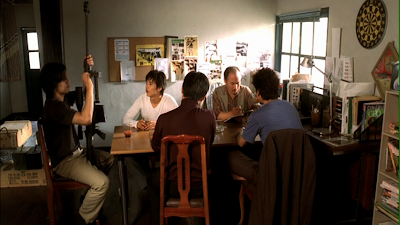March 3rd, 7:00PM in Garland 104 (2441 E. Hartford)
 The films of Director Kazuo Hara typically elicit questions on the role and limits of documentary film making. They are shocking, strange and some say criminal, but are they also profound? For his first film Goodbye CP (1972) Hara documented the scorn and isolation that sufferers of cerebral palsy experience in conformist Japan. In other films he would look at the changing role of women and the totality of a great artist, but for his third directorial effort he shoots an arrow into the heart of Japanese society.
The films of Director Kazuo Hara typically elicit questions on the role and limits of documentary film making. They are shocking, strange and some say criminal, but are they also profound? For his first film Goodbye CP (1972) Hara documented the scorn and isolation that sufferers of cerebral palsy experience in conformist Japan. In other films he would look at the changing role of women and the totality of a great artist, but for his third directorial effort he shoots an arrow into the heart of Japanese society. Kenzo Okuzaki is an angry World War II veteran of Japans Imperial Army. He suffered greatly and had a hard time reconciling his experiences in civilian life. Then after killing a man he discovered that he was a divine force of judgment on earth. Now he has pledged to uncover the truth about the execution of several Japanese soldiers at wars end.
Kenzo Okuzaki is an angry World War II veteran of Japans Imperial Army. He suffered greatly and had a hard time reconciling his experiences in civilian life. Then after killing a man he discovered that he was a divine force of judgment on earth. Now he has pledged to uncover the truth about the execution of several Japanese soldiers at wars end. Kenzo’s quest is documented including his interviews with witnesses and if they would stand against divine justice, then he has no choice but to use violence. Made over a five year period, Hara documents Kenzo’s activities, but never intervenes or expresses judgment of the man. This gives the film a stark and disturbing quality that most documentaries seem to shy away from.
Kenzo’s quest is documented including his interviews with witnesses and if they would stand against divine justice, then he has no choice but to use violence. Made over a five year period, Hara documents Kenzo’s activities, but never intervenes or expresses judgment of the man. This gives the film a stark and disturbing quality that most documentaries seem to shy away from.











 Television allowed many events to be broadcast live to a mass audience, this included several high profile crimes including a bank robbery. The interest in these events was so great that TV and film producers smelled a surefire profit and begun creating films and TV shows that to borrow a popular phrase, were ripped from the headlines.
Television allowed many events to be broadcast live to a mass audience, this included several high profile crimes including a bank robbery. The interest in these events was so great that TV and film producers smelled a surefire profit and begun creating films and TV shows that to borrow a popular phrase, were ripped from the headlines. 



